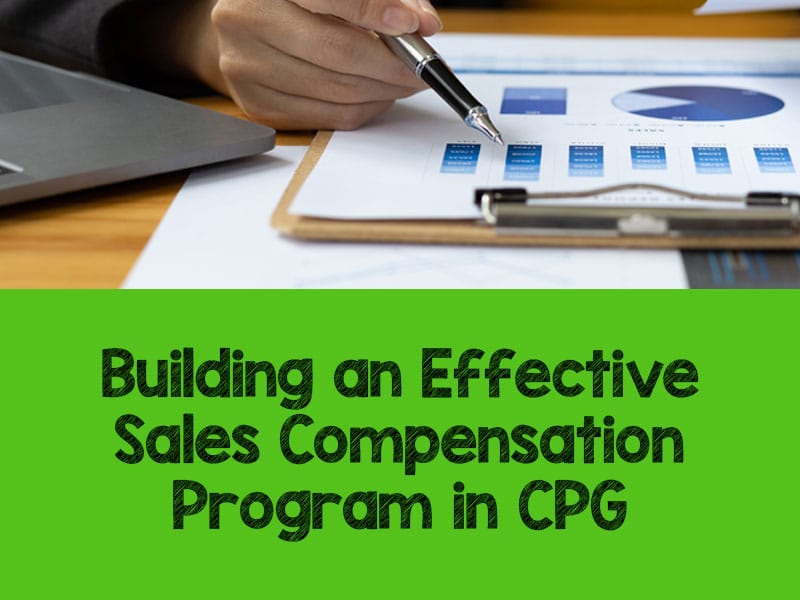
Imagine for a moment all the different roles the members of your sales team undertake. We guess you already have a sales compensation plan for each role. Right? So in this post we’re going to focus on the overarching nature of a sales compensation program.
What is a Sales Compensation Program?
Your sales compensation program is a broader initiative that includes not only the sales compensation plans you have for each role but everything related to compensating your sales teams. This includes
- a sound framework,
- strategies for deploying it,
- policies abut monitoring and reviewing, and
- clear communication and fair play practices.
In CPG, you have a wide variety of roles to encompass, and we’ll look at two of them in a moment.
But first, why is it important to get your sales compensation program right?
Why is an Effective Sales Compensation Program Important for Your CPG Business?
Like all businesses currently, you’re trying to attract and retain top talent. However, Millennials and Gen Z are not so keen to stay for money alone. They also want career benefits and a wider purpose that motivates and inspires them.
But excellent compensation still counts. So use it to motivate them and drive sales and revenue.
How to Design and Implement a Compensation Program
Set Sales Compensation Strategies
You need to make overall decisions about pay and benefits, including salary ranges per role, and how you will calculate bonuses.
Customize Plans for Different Sales Roles: Examples from CPG
Then, you need to sort out the various plans within that overall scenario. Here are two examples of a sales compensation plan. They each tailor the incentive structures within your sales compensation program to align with different CPG roles.
Field Sales Representatives (FSRs):
Because your FSRs are responsible for visiting retail stores and ensuring your products are well-stocked, prominently displayed, and promoted effectively, their compensation plan may include:
Base Salary – moderate, to provide financial stability, as their role involves frequent travel and in-store visits.
Merchandising Bonuses – tied to the quality of in-store product displays, with products visually appealing and complying with brand standards.
Sales Incentives – for achieving specific sales targets at the store level.
Store Visits – additional compensation for the number of successful store visits and audits completed.
Key Account Managers (KAMs):
Your KAMs are responsible for managing relationships with large retail chains and strategic accounts. So their role involves negotiation, account planning, and long-term partnership development. This means their compensation plan may look different:
Base Salary – competitive, reflecting higher-level responsibilities and strong account management skills.
Account Growth Bonuses – tied to growth and profitability (perhaps based on achieving annual revenue or volume targets).
New Item Distribution – tied to % ACV targets
Next Steps in Building Your Sales Compensation Program
First, you need to now check that your chosen compensation plan decisions still align with your organizational goals. They can get lost in the detail!
Second, you need to include in your sales compensation program two more factors:
1 How you will roll out the decisions and communicate them to everyone. Team work in sales is important and all reps from junior to expert need to feel your program is fair.
2 At this stage of the program building, you need to decide on a way to monitor sales performance that is communicable and accurate. One tip is to ensure reps enter accurate information in your CRM!
3 Make decisions about regular reviews, adjusting and fine-tuning.
Challenges and Considerations for Your Sales Compensation Program
Balancing Fixed and Variable Compensation
High fixed salaries provide financial stability but may reduce motivation to perform exceptionally! But a plan with too much variable compensation may lead to financial instability.
What are the norms in CPG? How will your decisions impact retention and motivation?
Ensuring Fairness and Equity
Communicate transparently about your program of compensation. But also seek feedback and address concerns of bias or discrimination in your program that might arise from, for example, different demographics.
Legal and Compliance Issues
Discuss how different jurisdictions might have specific laws regarding commission structures, minimum wage requirements, overtime, and discrimination.
Consult legal experts, stay updated on labor laws, and ensure your compensation program doesn’t inadvertently violate any legal or ethical standards.
How Momentum CPG Can Help
Momentum CPG has over 120 years of experience to help you with people, strategy, and processes that will build, compensate, and maintain a team of ace reps for your CPG business. Contact us today and let’s talk!